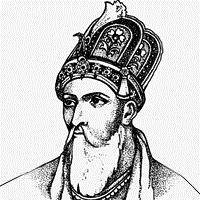Profile of Bahadur Shah Zafar
baat karnī mujhe mushkil kabhī aisī to na thī
jaisī ab hai tirī mahfil kabhī aisī to na thī
conversing has never been so diffficult for me
your company now is no more as it used to be
baat karni mujhe mushkil kabhi aisi to na thi
jaisi ab hai teri mahfil kabhi aisi to na thi
conversing has never been so diffficult for me
your company now is no more as it used to be
Mirza Abul Muzaffar Mohammad Sirajuddin (1775-1862), titled Bahadur Shah, who chose Zafar for a nom de plume, was born in the red fort of Delhi where he also received his education in Arabic and Persian, as well as in the arts of combating, and archery. He grew up with a deep interest in poetry, music, spiritualism, and calligraphy. He had a fine hand as a calligrapher and sent copies of his handwritten Quran to the prominent mosques of Delhi as gift. He came to the throne at the ripe age of sixty two only to rule a namesake empire that had lost its power and glory and had shrunk to the vicinity of the fort itself. A liberal emperor, who respected all faiths, loved peace, and was projected as a supporter of the 1857 uprising, was charged by the British government for treason and his role in a huge rebellion against the British Empire. With the entry of the British army in the city, he sought his refuge in the mausoleum of Humayun where he surrendered along with his wife Zeenat Mahal and two sons. He was arrested, imprisoned, and made to suffer a series of ignominies: the beheading of his three sons and a grandson; the hanging of their heads in display for long hours; the exile, imprisonment, and death of many princes in distress; and his own presentation before the British soldiers and others as a prisoner. Following legal proceedings spread over forty two days for raising a rebellion and indulging into treason against the British, a death sentence was pronounced against him which was later converted into an exile. In 1858, he was deported to Rangoon, now Yangon, the capital city of modern day Myanmar, then the British-controlled Burma, and was accompanied by his wife Zeenat Mahal, his two sons and a daughter-in-law. He spent the last four years of his life in this exile in utter misery and humiliation. The spot where he was buried remained untraceable till a mausoleum was erected in 1991 at a place which could possibly be the spot where he was buried. Zafar’s crown, taken away from the red fort along with many other gems and jewels of the royalty, is kept as an exhibit in the Royal collection in London.
Zafar was a sensitive poet who reflected ruefully on the decline of the Mughal Empire. His poetry is marked by a deep sense of pity and pathos, and for being a record of the miserable human predicament. He sought the advice of Mirza Naseer, then Zauq on his poetry. After the demise of Zauq, it was Ghalib who became his mentor. He also wrote an annotation of Sheikh Saadi’s Gulistan. Some critics have mentioned that much of his poetry was not written by him but was passed on to him by his mentors which does not hold well as the tone and tenor of his poetry is without doubt only his own and does not echo this mentors. Zafar has left behind a huge collection of ghazals in four volumes which constitute his Kulliyat.

